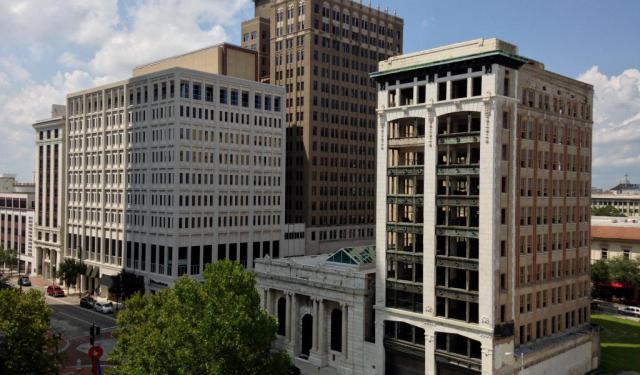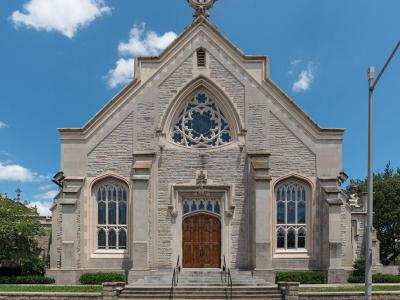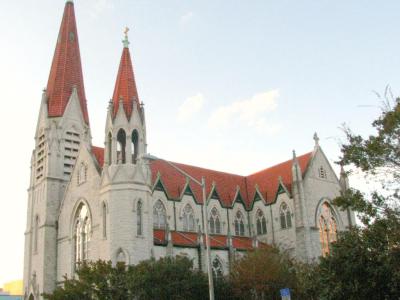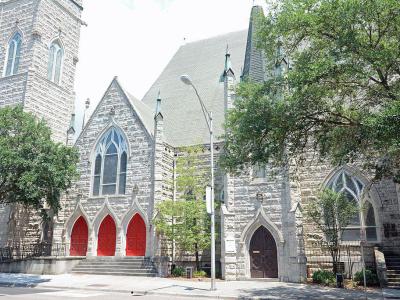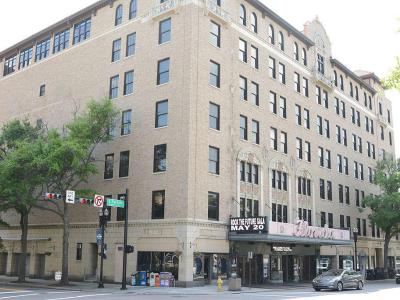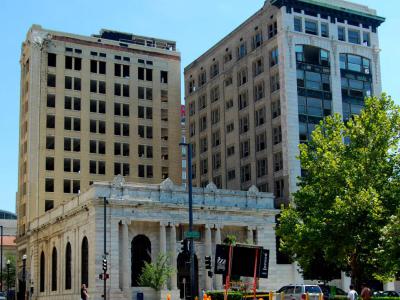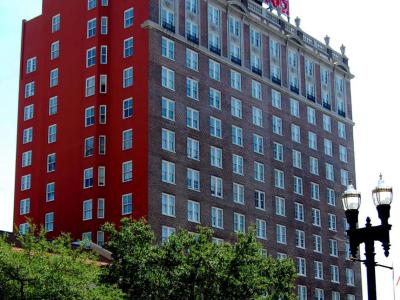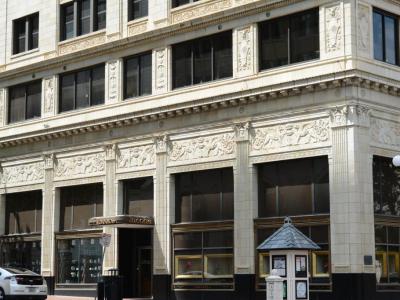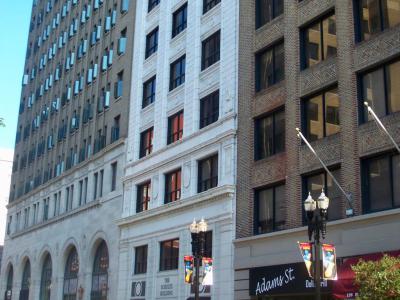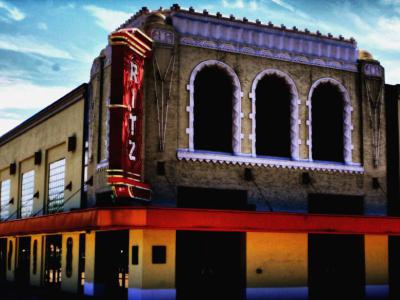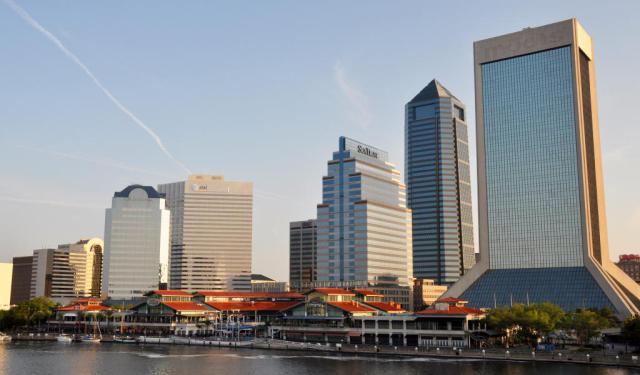Downtown Historical Buildings Walking Tour (Self Guided), Jacksonville
Downtown Jacksonville doesn’t need to shout to prove it has history-it just lets the buildings do the talking. Walk a few blocks, and you’ll pass through layers of ambition, recovery, reinvention, and more than a few architectural flexes.
Riddle time. Gothic arches, towering spires, and stained glass that catches the light just right- the Basilica of the Immaculate Conception makes you pause, even if you're in a rush. A short walk away is the First Presbyterian Church, quietly holding its ground as one of the oldest places of worship in the city. Modest on the outside, rich in stories within.
Follow the length of Laura Street, and you’ll meet the Laura Street Trio-a group of early 20th-century buildings that rose from the ashes of the 1901 fire and haven’t blinked since. They're an unofficial welcome sign to downtown’s architectural backbone. Just nearby, the Carling Apartments stand tall with a bit of old-school glamour. Once a luxury hotel, now high-end apartments, the building still wears its original details like a well-tailored suit.
On the same strett you’ll spot the Greenleaf and Crosby Building-look for the cast-iron street clock out front, still ticking like it has somewhere to be. Across the street, the Atlantic National Bank building doesn’t hold back: heavy limestone, bold lines, and the kind of confidence you only get from 1920s finance.
And then there’s the Ritz. In the LaVilla neighborhood, the Ritz Theatre and Museum carries the weight of Black cultural history with purpose and pride. Once a stage for legends, now a museum that curates memory through music, art, and the voices that shaped the city from the inside out.
Downtown Jacksonville doesn’t just preserve its past-it lets it live in the architecture, the stories, and the small details you might miss if you're only looking up. So take your time. Wander. Let the city tell you what it's built from-and who it’s built for.
Riddle time. Gothic arches, towering spires, and stained glass that catches the light just right- the Basilica of the Immaculate Conception makes you pause, even if you're in a rush. A short walk away is the First Presbyterian Church, quietly holding its ground as one of the oldest places of worship in the city. Modest on the outside, rich in stories within.
Follow the length of Laura Street, and you’ll meet the Laura Street Trio-a group of early 20th-century buildings that rose from the ashes of the 1901 fire and haven’t blinked since. They're an unofficial welcome sign to downtown’s architectural backbone. Just nearby, the Carling Apartments stand tall with a bit of old-school glamour. Once a luxury hotel, now high-end apartments, the building still wears its original details like a well-tailored suit.
On the same strett you’ll spot the Greenleaf and Crosby Building-look for the cast-iron street clock out front, still ticking like it has somewhere to be. Across the street, the Atlantic National Bank building doesn’t hold back: heavy limestone, bold lines, and the kind of confidence you only get from 1920s finance.
And then there’s the Ritz. In the LaVilla neighborhood, the Ritz Theatre and Museum carries the weight of Black cultural history with purpose and pride. Once a stage for legends, now a museum that curates memory through music, art, and the voices that shaped the city from the inside out.
Downtown Jacksonville doesn’t just preserve its past-it lets it live in the architecture, the stories, and the small details you might miss if you're only looking up. So take your time. Wander. Let the city tell you what it's built from-and who it’s built for.
How it works: Download the app "GPSmyCity: Walks in 1K+ Cities" from Apple App Store or Google Play Store to your mobile phone or tablet. The app turns your mobile device into a personal tour guide and its built-in GPS navigation functions guide you from one tour stop to next. The app works offline, so no data plan is needed when traveling abroad.
Downtown Historical Buildings Walking Tour Map
Guide Name: Downtown Historical Buildings Walking Tour
Guide Location: USA » Jacksonville (See other walking tours in Jacksonville)
Guide Type: Self-guided Walking Tour (Sightseeing)
# of Attractions: 9
Tour Duration: 2 Hour(s)
Travel Distance: 2.7 Km or 1.7 Miles
Author: sabrina
Sight(s) Featured in This Guide:
Guide Location: USA » Jacksonville (See other walking tours in Jacksonville)
Guide Type: Self-guided Walking Tour (Sightseeing)
# of Attractions: 9
Tour Duration: 2 Hour(s)
Travel Distance: 2.7 Km or 1.7 Miles
Author: sabrina
Sight(s) Featured in This Guide:
- Saint John's Cathedral
- Basilica of the Immaculate Conception
- First Presbyterian Church
- Florida Theatre
- The Laura Street Trio
- Carling Apartments
- Greenleaf and Crosby Building
- Atlantic National Bank
- Ritz Theatre and Museum
1) Saint John's Cathedral
Saint John’s Cathedral has never been one to back down from a challenge. It began humbly in 1842 as a modest wooden church-more splinters than stone-but the Civil War had other plans. The original structure didn’t make it through, succumbing to fire and fading into memory.
But Jacksonville has a habit of turning setbacks into blueprints. By 1877, a new Saint John’s had risen-grander, sturdier, and guided by the hand of architect Edward Potter. More than a building, it became a gathering place, a quiet refuge, and a symbol of enduring community spirit.
Then came the Great Fire of 1901, which once again tested the cathedral’s foundations-quite literally. The flames damaged much, but not the determination to rebuild. With thoughtful redesign, Saint John’s returned stronger, balancing its historical roots with renewed purpose.
By 1951, it was elevated to cathedral status, becoming the Episcopal Diocese of Florida’s official spiritual anchor. Today, Saint John’s stands not just as a house of worship, but as a resilient presence-weathered, refined, and quietly monumental in the heart of the city.
But Jacksonville has a habit of turning setbacks into blueprints. By 1877, a new Saint John’s had risen-grander, sturdier, and guided by the hand of architect Edward Potter. More than a building, it became a gathering place, a quiet refuge, and a symbol of enduring community spirit.
Then came the Great Fire of 1901, which once again tested the cathedral’s foundations-quite literally. The flames damaged much, but not the determination to rebuild. With thoughtful redesign, Saint John’s returned stronger, balancing its historical roots with renewed purpose.
By 1951, it was elevated to cathedral status, becoming the Episcopal Diocese of Florida’s official spiritual anchor. Today, Saint John’s stands not just as a house of worship, but as a resilient presence-weathered, refined, and quietly monumental in the heart of the city.
2) Basilica of the Immaculate Conception
If buildings could talk, the Immaculate Conception Catholic Church would probably speak in solemn tones-with a hint of drama. Towering above downtown Jacksonville since 1910, the edifice is a full-blown Gothic Revival statement carved in stone and lit with stained glass.
The story starts in 1905, when architect M. H. Hubbard decided Jacksonville needed something a little more... celestial. His blueprint was a symphony of arches, spires, and buttresses that whispered medieval Europe but shouted Florida ambition. Construction began in 1907, and three years later, the doors swung open.
Let’s talk specifics: the structure is cruciform in shape (that’s church-speak for “in the shape of a cross”), with decorative tracery windows and flying buttresses. Guidebook cathedral architecture this far. But the true show-stealer? That 178.5-foot steeple, topped with a gold-plated cross, once the tallest thing on Jacksonville’s skyline. For three solid years, it gave every ship captain, city dweller, and Sunday stroller a literal high point to look up to.
Despite the architectural drama, the interior doesn’t try to outshine the outside. It complements the grandeur with soaring ceilings, calm light, and a design meant to lift your gaze-and maybe your spirits.
In 1992, the church was officially added to the U.S. National Register of Historic Places. Not because it’s old (though it is), but because it’s that rare thing: a sacred space that doubles as an architectural mic drop.
So if you’re wandering around downtown and think you see a medieval cathedral rising out of the Florida pavement-you’re not hallucinating. You’ve just found one of Jacksonville’s most impressive landmarks.
The story starts in 1905, when architect M. H. Hubbard decided Jacksonville needed something a little more... celestial. His blueprint was a symphony of arches, spires, and buttresses that whispered medieval Europe but shouted Florida ambition. Construction began in 1907, and three years later, the doors swung open.
Let’s talk specifics: the structure is cruciform in shape (that’s church-speak for “in the shape of a cross”), with decorative tracery windows and flying buttresses. Guidebook cathedral architecture this far. But the true show-stealer? That 178.5-foot steeple, topped with a gold-plated cross, once the tallest thing on Jacksonville’s skyline. For three solid years, it gave every ship captain, city dweller, and Sunday stroller a literal high point to look up to.
Despite the architectural drama, the interior doesn’t try to outshine the outside. It complements the grandeur with soaring ceilings, calm light, and a design meant to lift your gaze-and maybe your spirits.
In 1992, the church was officially added to the U.S. National Register of Historic Places. Not because it’s old (though it is), but because it’s that rare thing: a sacred space that doubles as an architectural mic drop.
So if you’re wandering around downtown and think you see a medieval cathedral rising out of the Florida pavement-you’re not hallucinating. You’ve just found one of Jacksonville’s most impressive landmarks.
3) First Presbyterian Church
Long before Jacksonville had a skyline, traffic lights, or even sidewalks worth writing home about, there was the First Presbyterian Church. Established in 1840, it holds the bragging rights as the city’s oldest religious body.
The story really starts to pick up in 1844, when a retired sea captain named O. Conger dropped anchor on dry land and decided to play patron saint. Thanks to his generosity, the congregation secured a new sanctuary on Newnan Street. Just a few years later, in 1847, Conger helped again, funding the construction of an upgraded church. But it was Miss Phoebe Swart who truly gave things a makeover-her support in 1855 led to a full remodeling and expansion. She didn’t just donate money-she rewrote the blueprint.
Now, cue the Civil War. Instead of sermons and hymns, the church became a makeshift hospital. The pews cleared out, the altar stepped aside, and the sanctuary turned into a space for bandages and bravery. Through all of it, the church kept its doors-metaphorically, at least-open to those in need.
What you see today is a stately piece of Gothic Revival architecture that doesn’t scream for attention but gets plenty anyway. It’s equal parts spiritual landmark and visual anchor, with pointed arches, elegant lines, and two centuries worth of solemnity.
So when you're strolling through downtown Jacksonville and spot those spires reaching for the sky, take a moment. You’re not just passing a building-you’re walking alongside 180 years of faith, grit, and really good timing.
The story really starts to pick up in 1844, when a retired sea captain named O. Conger dropped anchor on dry land and decided to play patron saint. Thanks to his generosity, the congregation secured a new sanctuary on Newnan Street. Just a few years later, in 1847, Conger helped again, funding the construction of an upgraded church. But it was Miss Phoebe Swart who truly gave things a makeover-her support in 1855 led to a full remodeling and expansion. She didn’t just donate money-she rewrote the blueprint.
Now, cue the Civil War. Instead of sermons and hymns, the church became a makeshift hospital. The pews cleared out, the altar stepped aside, and the sanctuary turned into a space for bandages and bravery. Through all of it, the church kept its doors-metaphorically, at least-open to those in need.
What you see today is a stately piece of Gothic Revival architecture that doesn’t scream for attention but gets plenty anyway. It’s equal parts spiritual landmark and visual anchor, with pointed arches, elegant lines, and two centuries worth of solemnity.
So when you're strolling through downtown Jacksonville and spot those spires reaching for the sky, take a moment. You’re not just passing a building-you’re walking alongside 180 years of faith, grit, and really good timing.
4) Florida Theatre
Florida Theatre isn’t just a place to catch a show-it is where Jacksonville keeps its drama regal and its ceilings hand-painted. Since opening in April 1927, this downtown gem has been dazzling audiences with more flair than a red-carpet gala and enough architectural swagger to stop passersby in their tracks.
Born during Florida’s Mediterranean Revival craze, the theater is one of only four grand movie palaces from that era still standing in the state. Think soaring arches, lavish detailing, and a façade that practically insists you dress up. Its siblings in Pensacola, Lakeland, and Tampa may share the same theatrical DNA, but the Florida Theatre keeps things extra polished with ornamental sculpture, intricate carvings, and a marquee that still sparkles like it’s 1929.
Inside the building, you’ll find the kind of interior that makes you forget your popcorn entirely. Vaulted ceilings hand-painted like a Renaissance daydream, elaborate moldings, and chandeliers grand enough to make Versailles blush. The sloped auditorium-with over 1,900 seats-means everyone gets a good view, whether it’s a movie, a concert, or a standing ovation in the making.
Added to the National Register of Historic Places in 1982, the Florida Theatre is a venue which, without exaggeration, is part of cinematic history. And like any good star of the silver screen, it knows how to make an entrance-and leave a lasting impression.
Born during Florida’s Mediterranean Revival craze, the theater is one of only four grand movie palaces from that era still standing in the state. Think soaring arches, lavish detailing, and a façade that practically insists you dress up. Its siblings in Pensacola, Lakeland, and Tampa may share the same theatrical DNA, but the Florida Theatre keeps things extra polished with ornamental sculpture, intricate carvings, and a marquee that still sparkles like it’s 1929.
Inside the building, you’ll find the kind of interior that makes you forget your popcorn entirely. Vaulted ceilings hand-painted like a Renaissance daydream, elaborate moldings, and chandeliers grand enough to make Versailles blush. The sloped auditorium-with over 1,900 seats-means everyone gets a good view, whether it’s a movie, a concert, or a standing ovation in the making.
Added to the National Register of Historic Places in 1982, the Florida Theatre is a venue which, without exaggeration, is part of cinematic history. And like any good star of the silver screen, it knows how to make an entrance-and leave a lasting impression.
5) The Laura Street Trio
If downtown Jacksonville had a VIP section for architecture, the Laura Street Trio would be sitting front row, sipping espresso, and giving everyone its business card. This trio isn’t a band-but it hits all the right notes when it comes to history, style, and structural drama.
Let’s break down the cast. First up: the Old Florida National Bank, lovingly nicknamed the Marble Bank-and yes, the name checks out. Built in 1902, it’s the elder statesman of the group, wrapped in classical revival columns and marble grandeur.Credit for the elegance goes to architect Edward H. Glidden, who clearly had a thing for symmetry and timelessness.
Then there’s the Bisbee Building, added to the scene in 1909 and proudly flaunting its Prairie Style curves courtesy of Henry J. Klutho. This wasn’t just a pretty façade-it was the first high-rise in the South to embrace reinforced concrete. That’s right, this building was flexing structural innovation while others were still figuring out plumbing.
Rounding out the trio is the Florida Life Building, another Klutho creation, completed in 1912. It held the title of the tallest building in Florida for a while-just long enough to get bragging rights but not long enough to become unbearable about it. Its sleek lines and vertical reach echoed a Jacksonville charging into modernity.
Today, the trio is under renovation-so while the interiors are off-limits, the exteriors are still posing proudly for cameras. Side by side, they tell a layered story of post–Great Fire ambition, early skyscraper swagger, and a city itching to redefine itself.
So next time you’re wandering Laura Street, don’t just walk past-look up and meet three of Jacksonville’s oldest influencers still turning heads over a century later.
Let’s break down the cast. First up: the Old Florida National Bank, lovingly nicknamed the Marble Bank-and yes, the name checks out. Built in 1902, it’s the elder statesman of the group, wrapped in classical revival columns and marble grandeur.Credit for the elegance goes to architect Edward H. Glidden, who clearly had a thing for symmetry and timelessness.
Then there’s the Bisbee Building, added to the scene in 1909 and proudly flaunting its Prairie Style curves courtesy of Henry J. Klutho. This wasn’t just a pretty façade-it was the first high-rise in the South to embrace reinforced concrete. That’s right, this building was flexing structural innovation while others were still figuring out plumbing.
Rounding out the trio is the Florida Life Building, another Klutho creation, completed in 1912. It held the title of the tallest building in Florida for a while-just long enough to get bragging rights but not long enough to become unbearable about it. Its sleek lines and vertical reach echoed a Jacksonville charging into modernity.
Today, the trio is under renovation-so while the interiors are off-limits, the exteriors are still posing proudly for cameras. Side by side, they tell a layered story of post–Great Fire ambition, early skyscraper swagger, and a city itching to redefine itself.
So next time you’re wandering Laura Street, don’t just walk past-look up and meet three of Jacksonville’s oldest influencers still turning heads over a century later.
6) Carling Apartments
You’d be forgiven for mistaking The Carling for an old-world opera house or a European embassy-it’s got that kind of quiet confidence. Built in 1925 during Jacksonville’s architectural glow-up, this 13-story stunner came courtesy of New York architects Thompson, Holmes & Converse, who clearly decided the city could use a little Italian Renaissance glamour.
Let’s talk curb appeal. The lower floors are clad in solid Indiana limestone, giving the building a sense of strength and permanence. Above that, terra-cotta details add a touch of refined ornamentation. It’s tall, confident, and manages to look elegant without being overly showy.
Unlike most high-profile buildings that flaunt themselves on corner lots, The Carling makes a statement from mid-block. It’s thrown right into the fabric of downtown-unassuming until you look up and realize it for yourself.
In 1936, it got a rebrand and became the Hotel Roosevelt, gaining a reputation as a hot spot for visitors and events. But the story took a tragic turn in 1963, when a fire claimed 22 lives and abruptly shuttered the hotel’s doors. The building went quiet for almost two decades-no guests, no music, just a silent, smoke-scarred shell.
Eventually, it was brought back to life, this time as retirement apartments, with much of the original detailing intact. The bones were too good to waste. In 1991, The Carling officially earned its spot on the National Register of Historic Places, a nod to its architectural and cultural weight.
Today, The Carling stands tall not just for its looks, but for its layers-a structure that’s seen glamour, grief, reinvention, and revival, all from the center of Jacksonville’s ever-evolving downtown.
Let’s talk curb appeal. The lower floors are clad in solid Indiana limestone, giving the building a sense of strength and permanence. Above that, terra-cotta details add a touch of refined ornamentation. It’s tall, confident, and manages to look elegant without being overly showy.
Unlike most high-profile buildings that flaunt themselves on corner lots, The Carling makes a statement from mid-block. It’s thrown right into the fabric of downtown-unassuming until you look up and realize it for yourself.
In 1936, it got a rebrand and became the Hotel Roosevelt, gaining a reputation as a hot spot for visitors and events. But the story took a tragic turn in 1963, when a fire claimed 22 lives and abruptly shuttered the hotel’s doors. The building went quiet for almost two decades-no guests, no music, just a silent, smoke-scarred shell.
Eventually, it was brought back to life, this time as retirement apartments, with much of the original detailing intact. The bones were too good to waste. In 1991, The Carling officially earned its spot on the National Register of Historic Places, a nod to its architectural and cultural weight.
Today, The Carling stands tall not just for its looks, but for its layers-a structure that’s seen glamour, grief, reinvention, and revival, all from the center of Jacksonville’s ever-evolving downtown.
7) Greenleaf and Crosby Building
There’s nothing quite like a little architectural eccentricity to keep things interesting, and the Greenleaf & Crosby Building delivers it with flair. Built in 1927 for one of Jacksonville’s top-tier jewelry houses, this early skyscraper doesn’t just sparkle with history-it leans into it… a little unevenly.
The original blueprint called for a modest six-story structure. But somewhere between ambition and budget gymnastics, one half of the building stretched up to twelve stories while the other half... well, didn’t. Thus, a charmingly lopsided silhouette was born that has confused architects and delighted pedestrians ever since.
What it lacks in symmetry, it makes up for in detail. Cast your eyes skyward and you’ll spot terra-cotta panels packed with mythical griffins, imperious eagles, and enough decorative flourishes to make your neck sore. Down at street level, a soaring two-story arched entrance once ushered well-heeled customers into the Greenleaf & Crosby showroom-a gilded universe of gemstones, gold, and good taste.
And just outside? One of Jacksonville’s most beloved meet-up points: the Jacobs Jewelers clock. This cast-iron beauty, crafted in 1901, landed at the building’s corner in 1930 and has been keeping time ever since. At 2.2 tons, it doesn’t go unnoticed-and it probably wouldn’t move even if you wanted it to.
So, while the Greenleaf & Crosby Building may not win any awards for structural balance, it absolutely holds its own in Jacksonville’s skyline. It’s a little off-kilter, a lot of fun to look at, and a perfect reminder that elegance doesn’t always have to play by the rules.
The original blueprint called for a modest six-story structure. But somewhere between ambition and budget gymnastics, one half of the building stretched up to twelve stories while the other half... well, didn’t. Thus, a charmingly lopsided silhouette was born that has confused architects and delighted pedestrians ever since.
What it lacks in symmetry, it makes up for in detail. Cast your eyes skyward and you’ll spot terra-cotta panels packed with mythical griffins, imperious eagles, and enough decorative flourishes to make your neck sore. Down at street level, a soaring two-story arched entrance once ushered well-heeled customers into the Greenleaf & Crosby showroom-a gilded universe of gemstones, gold, and good taste.
And just outside? One of Jacksonville’s most beloved meet-up points: the Jacobs Jewelers clock. This cast-iron beauty, crafted in 1901, landed at the building’s corner in 1930 and has been keeping time ever since. At 2.2 tons, it doesn’t go unnoticed-and it probably wouldn’t move even if you wanted it to.
So, while the Greenleaf & Crosby Building may not win any awards for structural balance, it absolutely holds its own in Jacksonville’s skyline. It’s a little off-kilter, a lot of fun to look at, and a perfect reminder that elegance doesn’t always have to play by the rules.
8) Atlantic National Bank
If downtown Jacksonville had a résumé, the former Atlantic National Bank Building-now known as the Schultz Building-would be the bolded name at the top. Completed in 1909, this twelve-story tower dominated the skyline. For a brief but glorious spell, it was the tallest building in both Jacksonville and the entire state of Florida.
Apart from its sheer size, the visuals are notable as well. The bottom two floors are wrapped in creamy marble, the kind that practically whispers “old money.” Higher up, white terra-cotta ornamentation gives the top floors a little extra flourish. And above the main entrance? A subtle “ANB” engraving still marks the building’s original identity, back when Atlantic National Bank was the city’s financial heavyweight.
These days, the Schultz Building is less about vaults and ledgers and more about Wi-Fi and business casual. But don’t let the name change fool you-it still holds its historical ground while looking from above.
Now for the plot twist: there’s a tunnel. Beneath all that marble and terra cotta lies a leftover gem from the early 20th century-a still-functioning underground passage that once connected bank buildings like some kind of turn-of-the-century secret agent shortcut. It’s the only tunnel of its kind in Jacksonville that hasn’t been sealed off or forgotten, and yes, parts of it are still open to the public. No lasers, no booby traps-just an atmospheric stroll through downtown’s underground past.
So if you're walking past the Schultz Building, take a moment. Then maybe look down and wonder: what else is hiding under your feet?
Apart from its sheer size, the visuals are notable as well. The bottom two floors are wrapped in creamy marble, the kind that practically whispers “old money.” Higher up, white terra-cotta ornamentation gives the top floors a little extra flourish. And above the main entrance? A subtle “ANB” engraving still marks the building’s original identity, back when Atlantic National Bank was the city’s financial heavyweight.
These days, the Schultz Building is less about vaults and ledgers and more about Wi-Fi and business casual. But don’t let the name change fool you-it still holds its historical ground while looking from above.
Now for the plot twist: there’s a tunnel. Beneath all that marble and terra cotta lies a leftover gem from the early 20th century-a still-functioning underground passage that once connected bank buildings like some kind of turn-of-the-century secret agent shortcut. It’s the only tunnel of its kind in Jacksonville that hasn’t been sealed off or forgotten, and yes, parts of it are still open to the public. No lasers, no booby traps-just an atmospheric stroll through downtown’s underground past.
So if you're walking past the Schultz Building, take a moment. Then maybe look down and wonder: what else is hiding under your feet?
9) Ritz Theatre and Museum
Step into Jacksonville’s LaVilla neighborhood, and you’ll find a landmark that performs its history. The Ritz Theatre and Museum, reborn in 1929 with distinct Art Deco lines, stands on the site of its cinematic predecessor. More than a theater, it quickly became a cultural cornerstone, where music, dance, and storytelling lit up the stage and brought the neighborhood’s creative spirit into full focus.
Inside, the 426-seat auditorium has seen it all: toe-tapping concerts, dramatic monologues, high-energy dance, and films that reflect the Black experience with clarity and pride. Today, it continues to offer more than just entertainment-it delivers cultural memory with a mic and a spotlight.
The lobby, usually being an afterthought, it’s not just a pass-through. It’s a social mixer, a photo backdrop, a rented-out party venue, and the unofficial living room of La Villa.
But to understand the Ritz, you’ve got to understand LaVilla. Once known as the “Harlem of the South,” this neighborhood was a hotbed of Black art, politics, and nightlife from the Roaring Twenties through the early '70s. Icons played here, ideas sparked here, and people gathered here long before hashtags made it easy.
Then came the quiet years. As the decades wore on, La Villa dimmed. Crime ticked up, venues closed down, and the cultural heartbeat slowed. But it didn’t stop. In the 1990s, Mayor Ed Austin’s River City Renaissance program helped bring the neighborhood-and the Ritz-back into the spotlight. The theater reopened in 1999, not just restored but reimagined as a museum and cultural centre, anchoring the community once again.
And though most of the original structure is gone, a historic sign and one sturdy corner wall remain-a brick-and-mortar nod to resilience. So whether you're here for the music, the memories, or both, know this: the Ritz still knows how to put on a show.
Inside, the 426-seat auditorium has seen it all: toe-tapping concerts, dramatic monologues, high-energy dance, and films that reflect the Black experience with clarity and pride. Today, it continues to offer more than just entertainment-it delivers cultural memory with a mic and a spotlight.
The lobby, usually being an afterthought, it’s not just a pass-through. It’s a social mixer, a photo backdrop, a rented-out party venue, and the unofficial living room of La Villa.
But to understand the Ritz, you’ve got to understand LaVilla. Once known as the “Harlem of the South,” this neighborhood was a hotbed of Black art, politics, and nightlife from the Roaring Twenties through the early '70s. Icons played here, ideas sparked here, and people gathered here long before hashtags made it easy.
Then came the quiet years. As the decades wore on, La Villa dimmed. Crime ticked up, venues closed down, and the cultural heartbeat slowed. But it didn’t stop. In the 1990s, Mayor Ed Austin’s River City Renaissance program helped bring the neighborhood-and the Ritz-back into the spotlight. The theater reopened in 1999, not just restored but reimagined as a museum and cultural centre, anchoring the community once again.
And though most of the original structure is gone, a historic sign and one sturdy corner wall remain-a brick-and-mortar nod to resilience. So whether you're here for the music, the memories, or both, know this: the Ritz still knows how to put on a show.
Walking Tours in Jacksonville, Florida
Create Your Own Walk in Jacksonville
Creating your own self-guided walk in Jacksonville is easy and fun. Choose the city attractions that you want to see and a walk route map will be created just for you. You can even set your hotel as the start point of the walk.
Jacksonville Introduction Walking Tour
Jacksonville, Florida-a place where size does matter. Stretching its way into the record books as the largest city by area in the continental U.S., Jacksonville hugs the northeastern edge of the Sunshine State, where the St. Johns River meanders lazily toward the Atlantic.
Long before traffic jams and beach selfies, the Timucua people called this area home. Then came the usual suspects: Spanish... view more
Tour Duration: 2 Hour(s)
Travel Distance: 3.1 Km or 1.9 Miles
Long before traffic jams and beach selfies, the Timucua people called this area home. Then came the usual suspects: Spanish... view more
Tour Duration: 2 Hour(s)
Travel Distance: 3.1 Km or 1.9 Miles
The Most Popular Cities
/ view all
